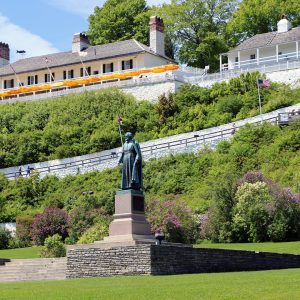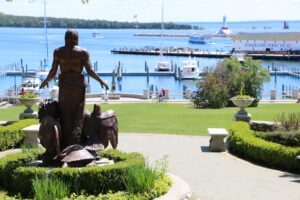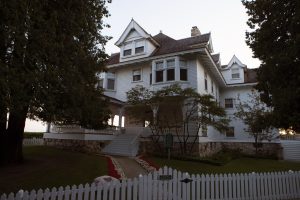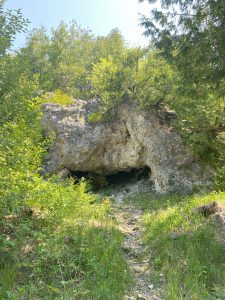Menu
Home / Visit / Plan Your Visit / Mackinac Island State Park Visitation Tips / Historic Sites and Monuments
It’s hard to find somewhere within Mackinac Island State Park that isn’t historic. Below is a summary of prominent historic sites and monuments, but there are always more to be found!
The reason Mackinac Island exists the way it does today. Fort Mackinac was constructed between 1779-1781 by the British during the American Revolution. This is a ticketed attraction. Learn more here.
A collection of historic sites found on Main Street, Fort Street, and Market Street in downtown Mackinac Island. Sites include The Richard & Jane Manoogian Mackinac Art Museum, Biddle House, featuring the Mackinac Island Native American Museum, Benjamin Blacksmith Shop, American Fur Co. Store & Dr. Beaumont Museum, and McGulpin House. All are ticketed attractions.
 Marquette Park and the Father Marquette Statue
Marquette Park and the Father Marquette Statue
For decades the area below the fort was used as a garden for growing vegetables. Soon after the fort was closed in 1895, the Park Commission transformed this area into a park in honor of Father Jacque Marquette. By 1907 landscaping was completed and, two years later, the statue by Gaetano Trentanove was added erected at the center of the park. Located on Main Street in front of Fort Mackinac. The park is available all year.
 Mackinac Island Peace Garden and “Be Still”
Mackinac Island Peace Garden and “Be Still”
Competed in 2015 as part of the bicentennial of the War of 1812. The statue commemorates 200 years of peace between the United States and Canada. Located within Marquette Park adjacent to The Richard & Jane Manoogian Mackinac Art Museum. It is a popular wedding venue. The Peace Garden is open all year.
 Michigan Governor’s Summer Residence
Michigan Governor’s Summer Residence
Completed in 1902 on a park leasehold, this palatial summer cottage was purchased by the Park Commission in 1944 and offered to the governor as an official summer residence. Located at the corner of Fort Street and Huron Road. Tours of the residence are held every Wednesday during the summer months (June-August) from 9:30 a.m. to 11:30 a.m.
Located on the north parade ground behind Fort Mackinac, the Scout Barracks was completed in 1934 as a Civilian Conservation Corps project. The Scout Barracks houses Boy or Girl Scout troops from all over Michigan on a weekly basis. Young people serve as guides in Fort Mackinac and other buildings. The program began in 1929 with a group of Eagle Scouts from southwest Michigan, among them future President Gerald R. Ford. The barracks are not open to the public.
This memorial, on the bluff to the east of the fort, to novelist and travel writer Constance Fenimore Woolson was erected in 1916. The bronze plaque and granite benches are in a lovely shaded area on the brow of the bluff overlooking the town and harbor. Woolson summered on Mackinac Island beginning in 1855 and set her novel Anne on the island.
 Skull Cave – Home of the Ancestors
Skull Cave – Home of the Ancestors
Mackinac Island has long been a burial location for the Anishnaabek (Odawa, Ojibway and Potawatomi). Some of the burials on the island are more than one thousand years old. It is a common practice for the Anishnaabek to bury their dead near water and their villages. Once their kin are interred, the Anishnaabek remember them in special ceremonies, often called “feasts of the dead” or “ghost suppers.” Michigan Odawa, Ojibway and Potawatomi communities hold these feasts in autumn. Located at the intersection of Rifle Range Road and Garrison Road.
The three island cemeteries are located on Garrison Road, north of Fort Mackinac. The oldest is the Fort Mackinac Post Cemetery, with the earliest interments probably occurring in the 1820s. As early as 1852, island residents began burying their dead near the post cemetery and moving burials from the old Catholic and Protestant cemeteries in town.
During the War of 1812, the British constructed a small fort on the highest point of the island, to better protect Fort Mackinac. Originally named Fort George, it was renamed by the Americans, following their return in 1815. The Americans continued to man the outpost for a few years, but eventually abandoned it. In 1934 a reconstruction, carried out by the Works Progress Administration and based on original plans, was completed. It was replaced by the current version in 2015. The Fort Holmes grounds are always open. The blockhouse is open May-October.
The 1814 Battlefield, now the home of Wawashkamo Golf Course, is located on British Landing Road. Here Americans attempted to recapture the island from the British, late in the War of 1812. The British won the battle, and only returned Mackinac Island to the United States following the Treaty of Ghent the following year. A marker and small turnout are across from the golf course.
Here British soldiers landed during their successful attack and capture of Fort Mackinac on July 16 and 17, 1812. On the northwest side of the island off M-185. Site also has a nature center, interpretive trail, picnic area, and bicycle repair station.
Located on Lake Shore Boulevard below Arch Rock, Dwightwood Springs is the most famous of the natural flows of clear, cold water that dot the island. The pergola and benches were donated in memory of Dwight Wood, son of Edwin O. Wood, an early summer cottager and member of the Mackinac Island State Park Commission.
Located on Fort Street in Marquette Park, this reconstruction commemorates the Jesuit Mission established on the island in 1670-71 by Fr. Claude Dablon and Jacques Marquette. Dablon had arrived in the winter and was joined in the spring by Marquette, who was traveling with a roving band of Huron who had been seeking a home ever since they were driven out of southern Ontario by Iroquois warriors in the 1650s.
The Somewhere in Time Gazebo is situated on a wooded bluff just east of Fort Mackinac, overlooking Marquette Park, the village of Mackinac Island, and Straits of Mackinac. This is the original gazebo from the movie Somewhere in Time, filmed on Mackinac Island. The romantic period drama, starring Jane Seymour and Christopher Reeve, was shot in 1979 and released in 1980. The gazebo, constructed for and used in scenes in the movie, remained on the island after filming. It was restored and moved to its current location in 2005. It is a popular wedding destination.
Located on Main Street in the eastern end of Mackinac Island’s historic downtown, Mission Church is Michigan’s oldest surviving church building. It is also the earliest surviving example of a New England Style church in the Midwest. Simple and elegant it was constructed by the island’s first Protestant congregation in 1830. Open to the public daily early May through early October. It is a popular wedding destination.
Located in the center of the island, the Mackinac Island Airport has been in existence since the 1920s. A modern terminal welcomes guests, and restrooms are available. Learn more here.